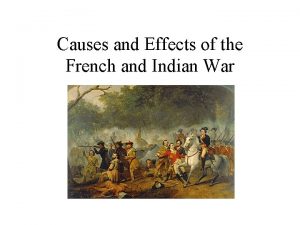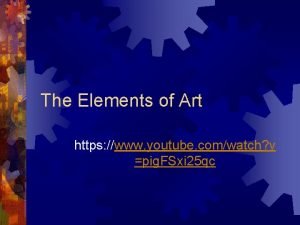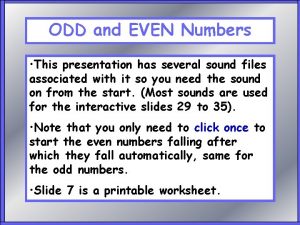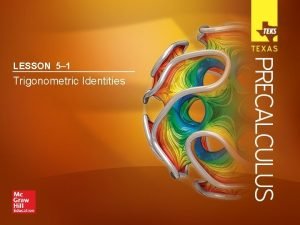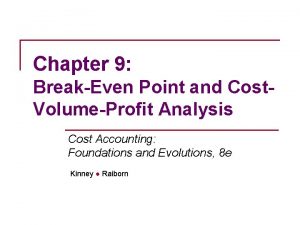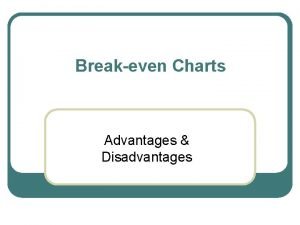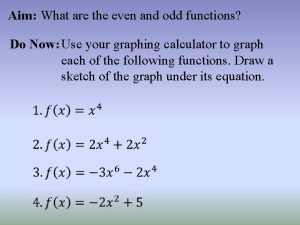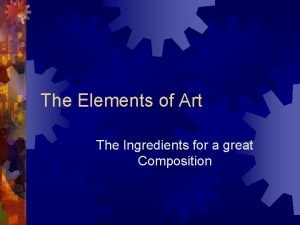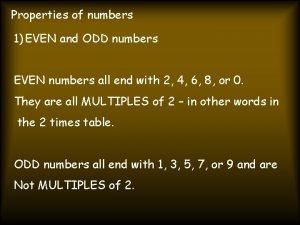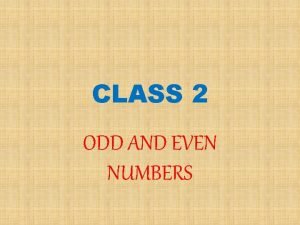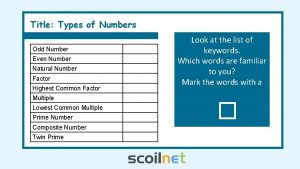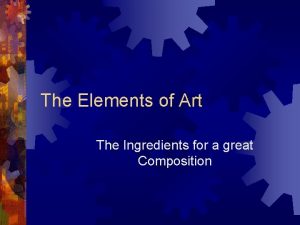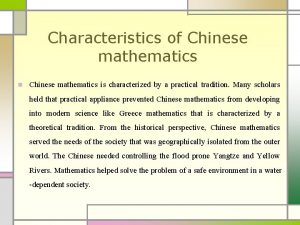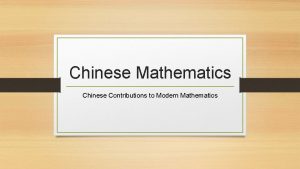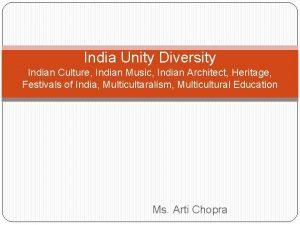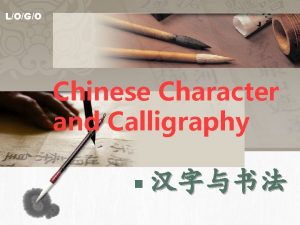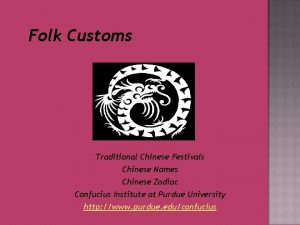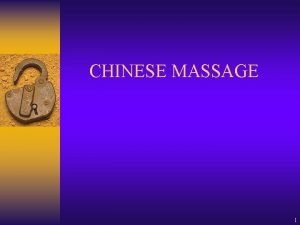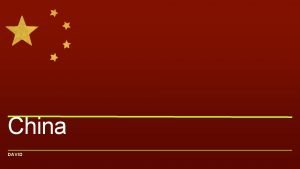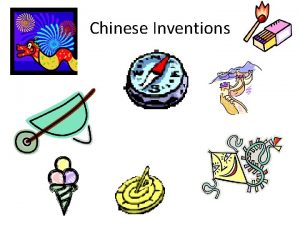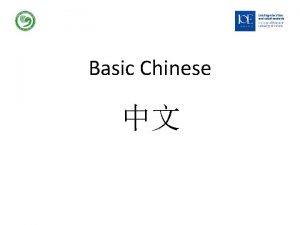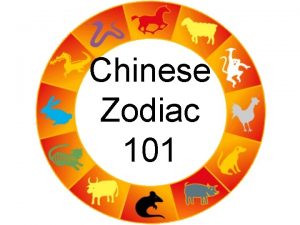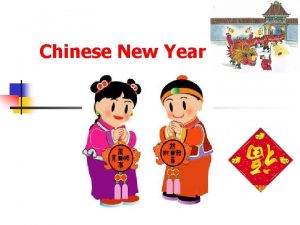Chinese and Indian Mathematics CHINESE MATHEMATICS EVEN AS



















- Slides: 19

Chinese and Indian Mathematics

CHINESE MATHEMATICS EVEN AS MATHEMATICAL DEVELOPMENTS IN THE ANCIENT GREEK WORLD WERE BEGINNING TO FALTER DURING THE FINAL CENTURIES BC, THE BURGEONING TRADE EMPIRE OF CHINA WAS LEADING CHINESE MATHEMATICS TO EVER GREATER HEIGHTS.

Ancient Chinese Number System The simple but efficient ancient Chinese numbering system, which dates back to at least the 2 nd millennium BC, used small bamboo rods arranged to represent the numbers 1 to 9, which were then places in columns representing units, tens, hundreds, thousands, etc. It was therefore a decimal place value system, very similar to the one we use today - indeed it was the first such number system, adopted by the Chinese over a thousand years before it was adopted in the West - and it made even quite complex calculations very quick and easy.

Ancient Chinese Number System

Abacus The use of the abacus is often thought of as a Chinese idea, although some type of abacus was in use in Mesopotamia, Egypt and Greece, probably much earlier than in China (the first Chinese abacus, or “suanpan”, we know of dates to about the 2 nd Century BC).

Abacus

Abacus

Lo Shu Square an order three square where each row, column and diagonal adds up to 15, is perhaps the earliest of these, dating back to around 650 BC (the legend of Emperor Yu’s discovery of the square on the back of a turtle is set as taking place in about 2800 BC).

But soon, bigger magic squares were being constructed, with even greater magical and mathematical powers, culminating in the elaborate magic squares, circles and triangles of Yang Hui in the 13 th Century (Yang Hui also produced a trianglular representation of binomial coefficients identical to the later Pascals’ Triangle, and was perhaps the first to use decimal fractions in the modern form).

“Jiuzhang Suanshu” or “Nine Chapters on the Mathematical Art” written over a period of time from about 200 BC onwards, probably by a variety of authors became an important tool in the education of such a civil service, covering hundreds of problems in practical areas such as trade, taxation, engineering and the payment of wages. It was particularly important as a guide to how to solve equations - the deduction of an unknown number from other known information - using a sophisticated matrix-based method which did not appear in the West until Carl Friedrich Gauss rediscovered it at the beginning of the 19 th Century (and which is now known as Gaussian elimination).

Early Chinese method of solving equations

Liu Hui Among the greatest mathematicians of ancient China who produced a detailed commentary on the “Nine Chapters” in 263 AD, was one of the first mathematicians known to leave roots unevaluated, giving more exact results instead of approximations. By an approximation using a regular polygon with 192 sides, he also formulated an algorithm which calculated the value of π as 3. 14159 (correct to five decimal places), as well as developing a very early forms of both integral and differential calculus.

“Tangram” proof of the Pythagorean theorem by Liu Hui, 3 rd century A. D. This is a reconstruction of the Chinese mathematician's proof (based on his written instructions) that the sum of the squares on the sides of a right triangle equals the square on the hypotenuse. One begins with a 2 and b 2, the squares on the sides of the right triangle, and then cuts them into various shapes that can be rearranged to form c 2, the square on the hypotenuse.

Chinese Remainder Theorem This uses the remainders after dividing an unknown number by a succession of smaller numbers, such as 3, 5 and 7, in order to calculate the smallest value of the unknown number. A technique for solving such problems, initially posed by Sun Tzu in the 3 rd Century AD and considered one of the jewels of mathematics, was being used to measure planetary movements by Chinese astronomers in the 6 th Century AD, and even today it has practical uses, such as in Internet cryptography.

By the 13 th Century, the Golden Age of Chinese mathematics, there were over 30 prestigious mathematics schools scattered across China

Qin Jiushao a rather violent and corrupt imperial administrator and warrior. who explored solutions to quadratic and even cubic equations using a method of repeated approximations very similar to that later devised in the West by Sir Isaac Newton in the 17 th Century. extended his technique to solve equations involving numbers up to the power of ten, extraordinarily complex mathematics for its time.

INDIAN MATHEMATICS DESPITE DEVELOPING QUITE INDEPENDENTLY OF CHINESE (AND PROBABLY ALSO OF BABYLONIAN MATHEMATICS), SOME VERY ADVANCED MATHEMATICAL DISCOVERIES WERE MADE AT A VERY EARLY TIME IN INDIA.

References www. youtube. com BBC - History of Indian Mathematics Part-2 of 2 – You. Tube BBC - History of Indian Mathematics Part-1 of 2 - You. Tube The History of Mathematics - BBC Documentary Part 8 - Dna. Tube. com Scientific Video and Animation Site http: //www. storyofmathematics. com/chinese. html http: //www. storyofmathematics. com/indian. html

Thank you! God Bless! PREPARED BY: EDMAR JOSEPH Q. FLORES
 Recursive language
Recursive language Regular expression of even even language
Regular expression of even even language Anglo chinese school chinese name
Anglo chinese school chinese name Toft instrument of israel
Toft instrument of israel Causes and effects of the french and indian war
Causes and effects of the french and indian war Shape that have smooth even edges and are measurable
Shape that have smooth even edges and are measurable 9 is even or odd
9 is even or odd How to score netball odds and even
How to score netball odds and even Lesson 5: the cosine function
Lesson 5: the cosine function How to find degree of operating leverage
How to find degree of operating leverage Identifying even and odd functions
Identifying even and odd functions Advantages and disadvantages of break even analysis
Advantages and disadvantages of break even analysis Determine whether a function is even or odd
Determine whether a function is even or odd Generally restful like the horison where the sky meets land
Generally restful like the horison where the sky meets land Properties of even numbers
Properties of even numbers Odd and even numbers for class 2
Odd and even numbers for class 2 Chapter 2 childhood days in calamba summary
Chapter 2 childhood days in calamba summary Even the youth shall faint and be weary
Even the youth shall faint and be weary Lcm of 8 and 9
Lcm of 8 and 9 Created when a line becomes connected and encloses space
Created when a line becomes connected and encloses space




